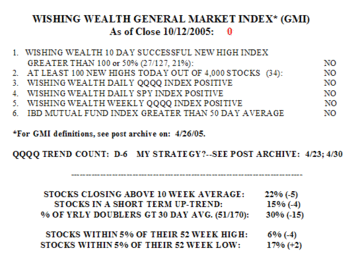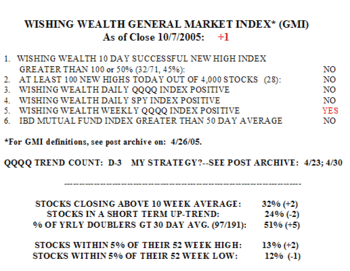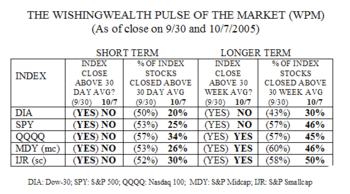Wednesday’s action pushed the GMI to zero. There were an amazing 324 new yearly lows and only 15 new highs in my universe of 4,000 stocks. Only 15% of the stocks are in a short term up-trend and only 22% closed above their 10 week averages.  Only 25% of the Nasdaq 100 and S&P 500 stocks rose on Wednesday, along with 33% of the Dow 30 stocks. Only 6% of stocks are within 5% of a new high, while almost three times as many (17%) are close to a new low. Only 30% (-15%) of the stocks that have doubled in the past year closed above their 30 day averages. So, even the best performing stocks are staggering. With the GMI at zero and stocks heading toward new lows, we might be in the throes of a burgeoning bear market. My university pension has been in cash for weeks and my IRA is now 96% in cash. I indicated last Sunday that the Darvas and O’Neil type growth stock strategies do best in markets that are at historic peaks. Now is not the time to be buying stocks in anticipation of new highs. It is time to be short or in cash. The CNBC pundits Wednesday morning were complaining that the market has no leaders. Nonsense! How about all of the stocks that are leading the market down. Bears can lead a parade too.
Only 25% of the Nasdaq 100 and S&P 500 stocks rose on Wednesday, along with 33% of the Dow 30 stocks. Only 6% of stocks are within 5% of a new high, while almost three times as many (17%) are close to a new low. Only 30% (-15%) of the stocks that have doubled in the past year closed above their 30 day averages. So, even the best performing stocks are staggering. With the GMI at zero and stocks heading toward new lows, we might be in the throes of a burgeoning bear market. My university pension has been in cash for weeks and my IRA is now 96% in cash. I indicated last Sunday that the Darvas and O’Neil type growth stock strategies do best in markets that are at historic peaks. Now is not the time to be buying stocks in anticipation of new highs. It is time to be short or in cash. The CNBC pundits Wednesday morning were complaining that the market has no leaders. Nonsense! How about all of the stocks that are leading the market down. Bears can lead a parade too.
Please send me your feedback at: silentknight@wishingwealthblog.com.

